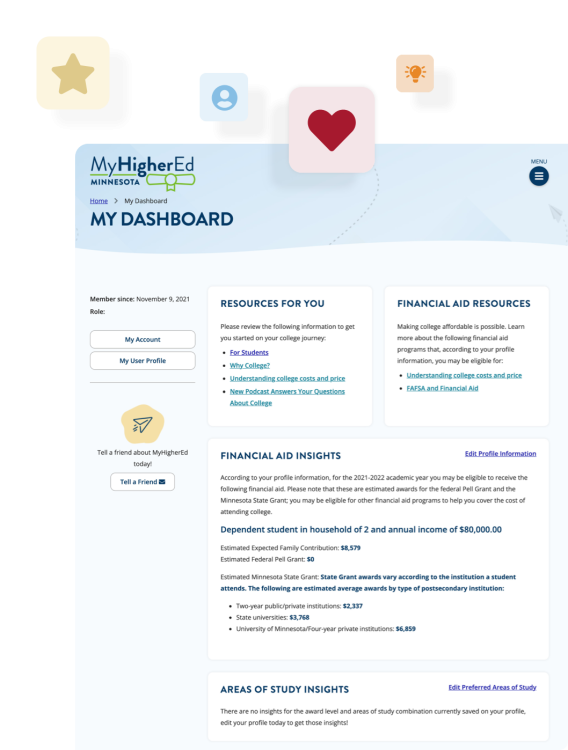Successfully navigating the transition from high school to a postsecondary institution, regardless of your students' choice, can be challenging. To some of your students, making independent choices about their lives and future may be overwhelming when faced with multiple options, so having an experienced adult they can trust to engage in an honest conversation about their academic and career goals could positively impact their experience.
Keep in mind that their classes will likely be more rigorous and, if they move to campus, it could be the first time they would living on their own, making these young adults responsible for applying themselves to succeed. Your guidance during high school can help set their expectations for the upcoming challenges in college.
Supporting their transition to college
Helping your students be prepared for what lies ahead can make that shift smoother for them and their families. Here is a list of areas where college-bound kids are likely to experience a shakeup. During your work with them, you may want to discuss these and other factors to be aware of during one of the biggest transitions of their lives.
Academic and environmental differences between high school and college
Choosing A College
This publication features a program grid to help your students explore and compare what Minnesota postsecondary institutions have to offer.
Class rigor
One big difference between high school courses and college courses, you may want to stress for your students, is the level of class rigor. This includes a change in the amount of homework, testing and use of different learning methods.
Even in Advanced Placement or Dual Credit courses, students are frequently assigned nightly homework and reading. However, in many introductory college classes there will be relatively few assignments throughout the semester, with a greater emphasis placed on midterm exams and final exams, or perhaps a large paper/project. Those will determine a student’s grade for the class. This may mean less time-consuming busy work, but far more pressure to do well on each assignment since it counts for such a large percentage of the overall grade.
Additionally, in high school, it is possible to do well in a class without ever opening a textbook if students focus and engage during class. In college, the material can change quickly, and the concepts may be more advanced, making it difficult to follow a lecture without doing the textbook reading beforehand.
A professor may assign chapters of reading beforehand and it is up to students to do the readings. Students often need to know both the lecture material and the textbook material for an exam since there are times when they don’t overlap.
Class sizes
For the duration of most students’ education, their classes have probably been in a classroom setting with between 25 to 30 classmates and a teacher. This environment made it easy to ask questions and get one-on-one attention from the teacher.
In college, the class size will differ depending on the university and course, but it is likely that at least a few of their classes will take place in a large lecture hall with one professor and a few hundred other students. This means there may be fewer opportunities to ask questions during a class. However, many professors or their assistants are available for questions during specified office hours.
Instructors
While in elementary, middle and high school students are taught by teachers whose purpose and passion is to educate students, sometimes on a variety of topics. First and foremost, they are specialized in educating and committed to helping their students learn core material and succeed.
Professors, on the other hand, are first and foremost academics or experts in the subjects they are teaching. This is a great, in that students learn from someone who knows more about what he or she is teaching than most. The downside is that some college students may not always get a professor who is well versed in the most effective teaching techniques, or as comfortable leading a classroom.
Attendance and class policies
There are strict attendance policies in high school, as well as rules that require students to stay seated during class, having to ask to use the restroom and only being able to walk outside with a hall pass. In college, there are no such rules.
In college, students are treated like adults and are trusted to make their own decisions. That includes choosing whether to attend class. While some professors do take attendance and may count it toward an overall grade, others do not, and leave it up to students to determine whether to attend.
While it may not be mandatory to attend classes, it’s encouraged. Students pay for their college experience and attending lectures is a piece of that. Additionally, while some college students feel like they can learn the material on their own, this can backfire when they end up missing a concept that was only discussed in lecture.
Schedules
You probably know better than anyone class scheduling and how it differs between high school and college. The high school environment is much more rigid, with students required to attend for a set number of hours every day. The only thing they can choose are a few elective classes to take during those hours. And even those choices can be quite limited given state and federal benchmarks and standards that each student must meet.
In college, determining a class schedule can be complex. Classes can occur anytime from 8 a.m. to 9 p.m., and students often find themselves with hours of gaps in between classes. There are times when a student’s desired classes overlap, don’t fit into his or her schedule, or are at capacity. One way to help is to ensure students understand the college class scheduling process and are prepared. They should spend time before the course registration period opens to choose which courses are needed and be ready to schedule them once registration opens.





